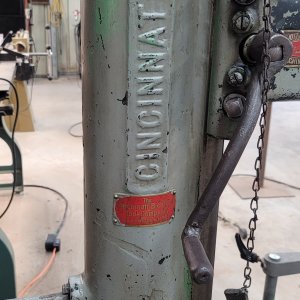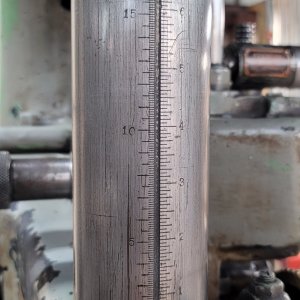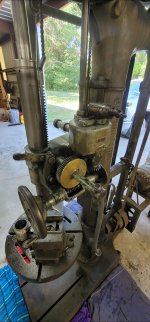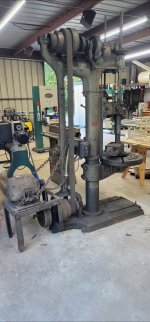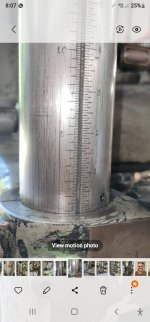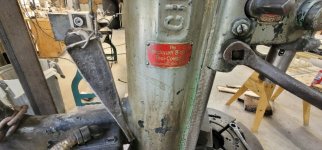I own a simpler & smaller version, a Cincinnati Bickford 25" drill- this model does not have the sliding head/quill, no enclosed gearbox for the power quill feed, open back gears. However, these old drills are somewhat generic in their designs. I use my C-B drill for heavier work, and have owned and used it for over 25 years.
Here are a few points and answers to your questions:
1. Re: where to find oil ports: anyplace there is a rotating shaft, there will be an oil port.Shafts for things such as the pinion to feed the quill will have drilled oil ports in the cast iron housings or frame of the machine. Smaller rotating shafts will all have oil ports as drillings, usually at the 12:00 position. My own C-B drill was heavily coated with a sludge of old oil mixed with dirt (aka 'grunge'). I cleaned the drill by scraping off the grunge, then with a strong detergent (Zep "Royal Purple", if I remember right), rinsing with water, and using diesel fuel and rags on the more stubborn grunge. As you clean you will 'unearth' oil ports. These will likely be choked with grunge. Use a piece of copper wire or an oxyacetylene torch tip cleaner (the fine wires have serrations on them) to open the oil drillings, then stick a 'wand' into them and spritz in automotive brake cleaning solvent. Wear eye protection when doing this, and if you are working indoors, have good ventilation and/or wear a
respirator with proper cartridges for chemical vapors. Blasting out the oil drillings with automotive brake cleaner will flush the remaining grunge back up and out of the drillings.
There are a few very important oil ports to locate and clear. These are located at the top and bottom of the spindle quill (the part of the spindle assembly which does not rotate is often referred to as the 'quill'). The top oil port on the quill will be something of a notch, and the lower oil port will be a drilling into the quill as you face the drill press from the front. As you move up the drill, there should be an oiler on the front of the top of the main frame, just under the 'crown' gear. This oils the top spindle bearing. As you continue up the drill, get a stepladder and clean the top of the crown gear (the larger bevel gear the spindle passes up thru). As you inspect the top of the crown gear, you will likely see an oil hole. This is to lubricate the thrust bearing under the crown gear, between the crown gear and top of the mainframe/upper spindle bearing. Make sure this port is cleaned out.
On the top and bottom of the quill, there will be thrust bearings for the spindle. The top thrust bearing will likely have a semi-split nut to adjust end play. Not sure about your C-B drill, but it may have ball thrust bearings top and bottom on the quill. Check the thrust adjustment to set a light preload if ball thrust bearings are used. If a plain thrust bearing (bronze or hard bakelite washers) is used, adjust to about 0.003-005" free play using feeler gauges. These thrust bearings are oiling points and important ones.
2. Re: Oil to use: I use ISO 46 oil. These older machines were designed to use what is still known as a "DTE" oil (dynamo, turbine, engine), an oil designation which predates the automobile and is still used in industrial and powerplant lubricant designations. I use "Tractor Hydraulic Oil", which is a DTE "medium-light" oil, ISO 46 weight (about SAE 20 weight) and contains anticorrosion and anti foam additives. Do NOT use automotive gear oils anywhere on your drill. Gear oils contain additives which can attack 'yellow metals' such as brass and bronze. You can use a heavier bodied oil on the feed gearing, something like a 'way lube'. An open gear lube is good to use on the heavier gearing such as the bevel gearing on the spindle and back gearing. Cautionary note is that open gear lubes are tacky and will catch and hold airborne dust and debris (such as grinding dusts, sawdust, and similar).
3. Larger bearings, such as on the top shaft & bottom cone pulley shaft will have 'oil port covers' on them. These will be either hinged lids or rotatable 'oilers'.
Check the free play in the top shaft (the horizontal shaft with the smaller bevel pinion gear driving the spindle). Use a small pinch bar & dial indicator. These
will be babbitted bearings and have shims in them. You may find things a bit loose if the drill did not get proper lubrication and maintenance. I believe these to be
the only adjustable bearings (other than spindle thrust) on the drill. I'd go for about 0.003"-0.005" free play in the top shaft bearings (a WAG -wild ass guess).
4. There is NO place to look for parts. These drills are ancient history. If you are missing a part other than something common like bolts or shaft keys or taper pins,
you are on your own to solve the problem. Reverse-engineering is the order of the day. Working with old machine tools requires a person to be resourceful and
able to reverse engineer and make replacement parts (or to repair damaged parts using welding, brazing, new steel, etc).
5. Never treat this drill as a 'lightweight'. It is a serious 'real machine tool' when compared to the round-column vee-belt drive drill presses in common use. This type drill produces several orders of magnitude more torque than any of the vee-belt driven lighter drill presses. If you are doing any work on this drill, clamp it to the table using tee bolts, slotted hold down dogs or straps, or any other secure clamping means. If you use a drill press vise, clamp it to the table. If a drill grabs on this type machine, it will wind up anything loose- the job, the vise, and you- if you are hanging onto it. If you are getting wound up by the drill and manage to punch the 'off' button, the stored energy in the rotating parts will keep on winding you in as things coast down. DO NOT underestimate this type drill when using smaller diameter drills in it.
I keep an assortment of 'jewelry' (hold down hardware such as all thread rod/nuts, slotted links, flatbar with holes drilled in it for holding previous jobs, tee nuts, etc) in containers by my own C-B drill. I also made an oil can from a damaged 1 pint pump oil can. The flex spout was gone, and I fished this can out of a trash container years ago. I made an extended spout out of 1/4" diameter stainless steel tubing bent at 90 degrees rather than straight up off the center of the can's pump top.
This spout has a pointed nozzle made from O-1 with a slight relief filed on it. It lets me get to the oilers and oiling points on my C-B drill and other old machine tools. The pointed nozzle is made small enough to depress the ball in spring-loaded oil-hole covers. By filing about half of the point away, oil is able to flow into the spring-loaded ball covers on oil holes. A complete nozzle point would not allow much oil flow. I keep a short stepladder handy with my C-B drill. It lets me get to the oiling points on top of the drill.
Another point: get in the habit of taking the flat belts off the pulleys when you are not using the drill. In humid weather, leather belts will stretch and take a permanent set, becoming too slack to transmit much, if any, power. I leave the flat belt (2" leather belt on my C-B drill) run off the cone pulleys when not in use.
I joke that between giving all the oiling points a drink and putting the belt back on, as well as making the setup to hold the work, I spend more time than drilling the actual holes with my C-B drill. But, it is a great old machine for pushing larger diameter drills thru steel and similar. Years ago, I had a job to drill a bunch of 1 1/4" diameter holes in some locomotive leaf spring material. I made a quick drill jig from A36 flatbar and punched 1/4" pilot holes thru the spring material. I opened the holes with taper-shank bits, drill in back gear, using the power quill feed. I was taking chips away with a shovel and wheelbarrow. A great old drill, for sure. I had made a setup for clamping the spring leaf material to the table, and used a piece of hardwood between the spring leaf stock and table.
Another point: I keep an assortment of hardwood blocking and board cutoffs by the C-B drill to use in setups where the drill needs something to run into, or for holding rough work such as castings or welded steel parts where surfaces are neither flat and may be some odd shape. Never throw away any hold-down items you made for a job. You may wind up needing them again, or may be able to modify them for another subsequent job.
No matter how much care you lavish on old machine tools, they are still not going to develop any affection for you. If you get too familiar or are hasty or cut corners in terms of setup and clamping of work, the old drill will not bat an eyelash nor breathe hard as it winds you in. These machine tools were built in an era when there was no OSHA, and it was an era when people were expected to use their own brains to figure things out and take responsibility for their own actions. Few guards, no emergency shutdown features, no 'safety warning stickers'. It is on the person using these old machine tools to figure things out and work safely.





